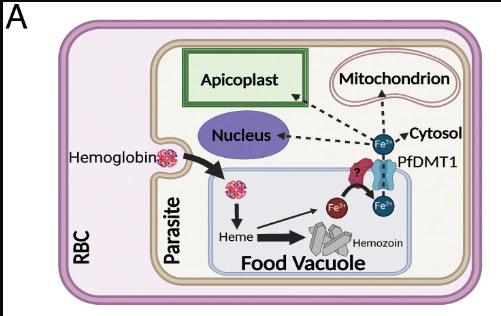
Plasmodium falciparum malaria parasites invade and multiply inside red blood cells (RBCs), the most iron-rich compartment in humans. Like all cells, P. falciparum requires nutritional iron to support essential metabolic pathways, but the critical mechanisms of iron acquisition and trafficking during RBC infection have remained obscure. Parasites internalize and liberate massive amounts of heme during large-scale digestion of RBC hemoglobin within an acidic food vacuole (FV) but lack a heme oxygenase to release porphyrin-bound iron. Although most FV heme is sequestered into inert hemozoin crystals, prior studies indicate that trace heme escapes biomineralization and is susceptible to nonenzymatic degradation within the oxidizing FV environment to release labile iron. Parasites retain a homolog of divalent metal transporter 1 (DMT1), a known mammalian iron transporter, but its role in P. falciparum iron acquisition has not been tested. Our phylogenetic studies indicate that P. falciparum DMT1 (PfDMT1) retains conserved molecular features critical for metal transport. We localized this protein to the FV membrane and defined its orientation in an export-competent topology. Conditional knockdown of PfDMT1 expression is lethal to parasites, which display broad cellular defects in iron-dependent functions, including impaired apicoplast biogenesis and mitochondrial polarization. Parasites are selectively rescued from partial PfDMT1 knockdown by supplementation with exogenous iron, but not other metals. These results support a cellular paradigm whereby PfDMT1 is the molecular gatekeeper to essential iron acquisition by blood-stage malaria parasites and suggest that therapeutic targeting of PfDMT1 may be a potent antimalarial strategy.

